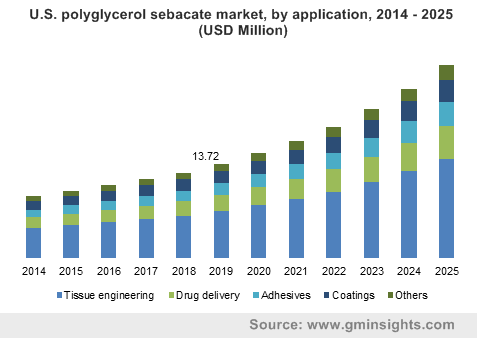North America Polyglycerol Sebacate Market to witness substantial growth over 2019-2025, tissue engineering application poised to transform the industry dynamics
Publisher : Fractovia | Published Date : 2019-03-11Request Sample
Rising geriatric population around the world and harmful environmental factors are expected to drive the global polyglycerol sebacate market over the coming years, owing to increased application in tissue engineering and drug delivery applications. Polyglycerol sebacate (PGS) is a bio-degradable material and is considered suitable for use inside the body, as the material gradually decomposes as it fulfils its purpose. In conjunction with the rapidly advancing field of biotechnology and medical innovations, the polyglycerol sebacate industry is anticipated to see tremendous consumption by biomedical companies who aim to offer long-term treatment options for cardiovascular and bone defect problems
U.S. polyglycerol sebacate market, by application, 2014 - 2025 (USD Million)

Essentially, PGS would allow these companies to create reliable biomaterial for tissue engineering purposes to replace damaged natural tissues. Health issues at the root of these problems, like diabetes, obesity and stress, are also on a rise due to evolving lifestyle, offering growth opportunities for the polyglycerol sebacate market.
Conventionally, poly glycolic acid (PGA) and poly lactic acid (PLA) had been the preferred bioresorbable materials for fabricating resorbable implants, which are devices built to achieve a function in the body and then be resorbed within it. However, these materials do not offer much elasticity which is observed in natural tissues and organs, besides leaving inflammation in the body after they are resorbed. Subsequently, PGS was developed for addressing the disparity between stiff PGA or PLA implants and the soft tissues. PGS is better match to human tissues and is also found to promote healing without any serious inflammatory response. As a result, surging investments in regenerative medicine for the development of biomaterials to grow implantable organs will provide a novel application base for the polyglycerol sebacate market.
Worldwide, almost 17.9 million people succumb to cardiovascular diseases (CVD) every year, representing nearly 31% of all deaths globally, according to Word Health Organization statistics. The U.S. also experiences a considerably large number of CVD cases annually, accounting for about 1 in every 3 deaths in the country. As reported by the American Heart Association Research in 2018, approx. 92.1 million adults in America are living with some kind of CVD or the after effects of stroke, demonstrating the massive need for developing solutions to better manage heart failure. Tissue engineering is being hailed as an enhanced alternative to mechanical support or organ replacement, promising a lucrative future for the polyglycerol sebacate industry. North America comprises of some of the most advanced research and healthcare facilities around the globe, further reinforcing the growth potential of the tissue engineering segment.
Another key aspect that will significantly influence the North America polyglycerol sebacate market is the prevalence of obesity in the region, which is a major cause of CVD as well as bone defects among both, the elderly and young adults. Since regenerative medicine is pegged as a better long-term solution for repairing damaged tissues, PGS could form a prominent component of implants used to treat the problems caused by obesity, such as replacing bone tissue, cartilage tissue and in some vital organs. A penchant for fast food and unchecked drinking habits in the U.S., Canada and Mexico have led to alarming severity in number of over-weight people at risk of a serious disorder. For the period between 2015 to 2016, nearly 93.3 million adults in the U.S. were affected by obesity, affirming the prospects for tissue engineering application in the region and the need for the polyglycerol sebacate industry.
All in all, continuous rise in the occurrence of disorders related to obesity, including diabetes and CVD, will accelerate the utilization of PGS as a bioresorbable material, ensuring a consistent source of revenue for the polyglycerol sebacate market. Critical innovations, for instance the development of implantable sensor monitors to track the healing of tissues and tendons, will entail an increased demand for the material. Growing expenditure on healthcare services and the adoption of modern production methods like 3D printing will enormously boost to the North America polyglycerol sebacate industry with regard to the tissue engineering application.